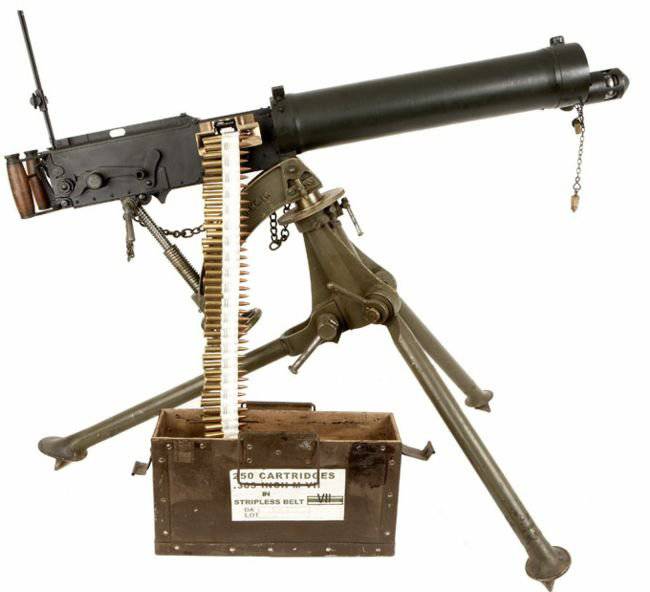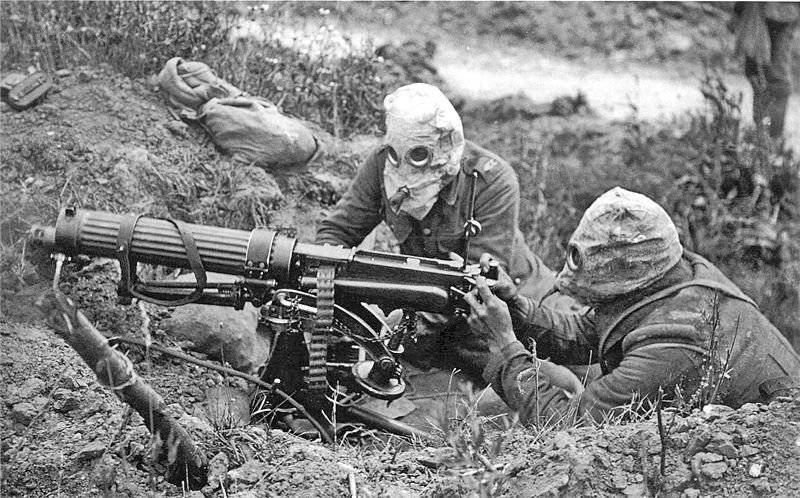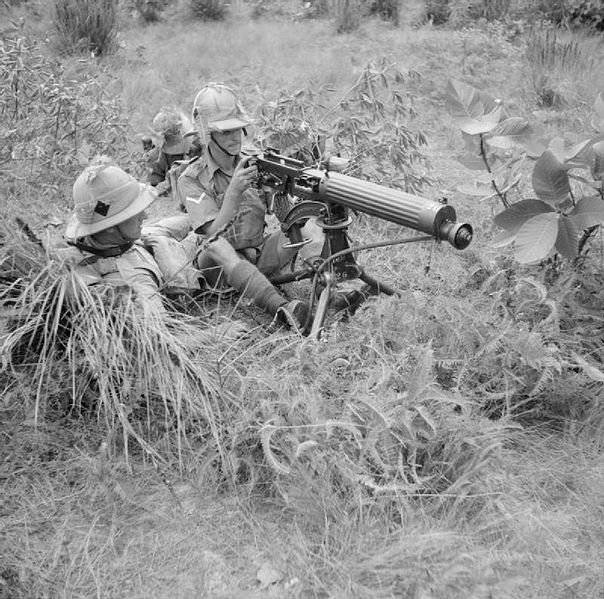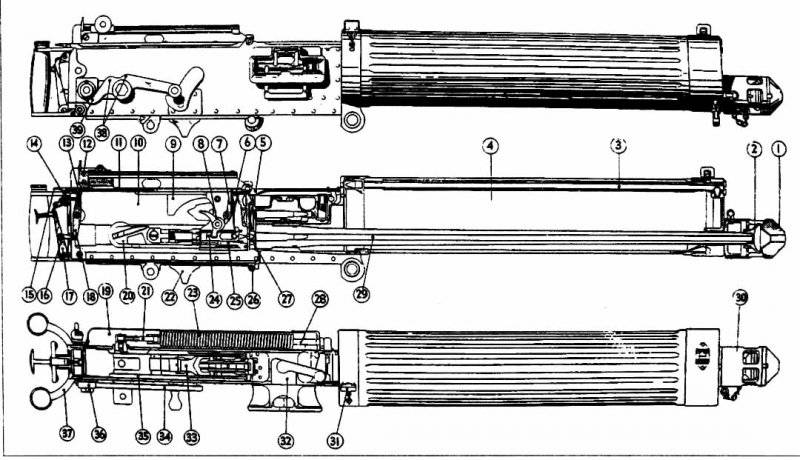Machine gun "Vikkers"

In England, in November 1912, after modifications, the Vickers machine gun was adopted. It has been used for more than 50 years. Vickers-Armstrong Ltd., Vickers, Son and Maxim Ltd., Royal Ordnance were engaged in its production. In the First World Machine Gun "Vickers" was produced under the English, Russian and French ammunition.
The main difference between the Vickers machine gun and the Maxim machine gun was a lock turned upside down by 180 degrees, folding the crank and the connecting rod upwards and throwing down the spent cartridges. This made it possible to reduce the height of the box, as well as facilitate the system. Accordingly, the trigger and grip have changed. The mass of the barrel was 2,036 kilogram. At the same time, the design of the muzzle was changed - a muff was mounted in the muzzle (screwed onto the barrel), behind which was a conical buffer coil spring, which softened the blow to the muzzle's bottom. The mass of the moving system was equal to 4,289 kilograms, the barrel rollback length was 23 millimeters, the shutter - 100 millimeters. Could be installed and heavy trunk "Maxim". The lid of the box was divided into two parts: the front cover closed the receiver, the back - the box. This design increased the convenience of service - in case of a delay in the supply of the tape, there was no need to open the entire system. For fixing the folding butt plate served two valves. Hard curly combs on the lid of the box served to lower the combat larva while moving backwards. In addition, the Vikkers machine gun was easier to manufacture - the number of parts was equal to 198.
Machine gun "Vikkers" Mk I (in Russia - machine gun "Vikkers" sample 1910 year) had a casing with or without fins (smooth). and its capacity was equal to 4,1 liters. Muzzle had a removable cap. Sight - rack. The English version was notched to 2,4 thousand yards (2190 meters) for long-range bullets of Mk 8Z cartridges. The front sight had a rectangular cross section and was protected by side ears. The aiming line had a length of 920 millimeters. With the help of a panoramic sight could be fired "on the squares", while the maximum range reached 4,5 thousand yards (4,1 thousand meters).
Device machine gun "Vikkers":
1 - muzzle bushing, 2 - muzzle coupling, 3 - steam discharge tube rear box cover, 4 - sight, 5 - trigger pull, 6 - fuse, 7 - latch, 8 - pull down, 9 - pull, 10 - release spring, 11 - return spring box. 12 - handle, 13 - chain, 14 - vertical stop mechanism stop, 15 - return spring, 16 - drummer, 17 - lower descent, 18 - deadbolt, 19 - larva hook, 20 - return spring adjusting screw, 21 - reversing screw of the larva, 22 - return spring adjusting screw, 23 - adjusting screw of the return spring, 24 - return spring adjusting screw, 25 - fixing screw of the larva, 26 - return spring adjusting screw, 27 - adjusting screw of the return spring, 28 - adjusting screw of the larva, 29 - return spring adjusting screw, 30 - fixing screw of the return spring, 31 - adjusting screw of the larva, 32 - adjusting screw of the return spring, 33 - fixing screw of the larva, 34 - adjusting screw of the return spring, 35 - fixing screw - Nadulnik, 36 - filling plug, 37 - receiver, 38 - locking levers, 39 - reloading handle, XNUMX - frame, XNUMX - roller, XNUMX - operating handle, XNUMX - copying tabs, reloading, XNUMX - control knob, reloading handle, XNUMX - reloading handle, reloading handle, XNUMX - reloading handle, reloading handle, XNUMX - reloading handle
The Vickers tripod mk 4 consisted of the base of the skeleton, one back and two front legs hinged on it, a horizontal guidance mechanism, a swivel, a vertical fine-tuning screw mechanism with a flywheel, and board mounts. The swivel consisted of two bent beds and an axial pin. The position of each leg was fixed with a clamp and a radial notch. Fire could be from a sitting or lying position. The back leg was supplied with a coulter, the front legs with boots. The bar on the rear leg of the machine was used as a support for the machine gunner’s knees or elbows, which increased stability during firing. Later, the tripod was simplified - a transverse bar was pulled away from the back leg, now it has a carrying strap and a spare parts bag. An anti-aircraft stance was designed to the machine, allowing circular fire. The elevation angle reached 75 degrees.

Machine guns "Vikkers" except England were produced in the United States, Portugal and Australia. Before the United States entered the war, the US military assessed weapon Entente, after that in December 1916 of the year it ordered the company Colt 4 thousand Vickers machine guns.
Already in 1914, the Vickers machine guns were installed on the plane. In 1916, the Vickers Mk I * (SU) was launched, which had air cooling and a synchronizer rod, allowing firing through a screw. Front and back in the barrel casing there were ventilation holes. The weight of the machine gun was 13,5 kilograms, the abbreviation SU means that the machine gun has an increased rate of fire. The speed was increased using a buffer that increased the initial roll-up speed of the mobile system. Vickers machine guns used French and Russian aviation. "Vickers" were the weapons of the first tanks Mk I.
The sequence of actions when unloading the machine gun "Vickers": from the bottom of the receiver tray on the right side, press a finger and remove the cartridge belt. Take back the cocking handle and turn it around, examine the chamber. Release the handle and pull the trigger.

Specifications of the machine gun "Vikkers" sample 1909 year:
Cartridge - .303 "British Service" (7,71x56);
The mass of the "body" of the machine gun without coolant - 18,1 kg;
The length of the "body" of the machine gun - 1156 mm;
Barrel length - 724 mm;
Quantity of rifling - 4;
The length of the stroke rifling - 254 mm;
Initial bullet speed - 745 m / s (Mk 7Z);
Sighting range - 3380 m;
Effective range - 1000 m;
The rate of fire - 600 shots per minute;
Combat rate - 125-200 shots per minute;
Tape capacity - 250 cartridges;
Type of machine - tripod;
Machine weight - kg 17,3;
The height of the line of fire - mm 300-729;
The angle of horizontal guidance - 45 degrees;
Vertical guidance angles - from -35 to + 53 degrees.
Based on: S. Fedoseev - Machine Guns in the First World War

Information